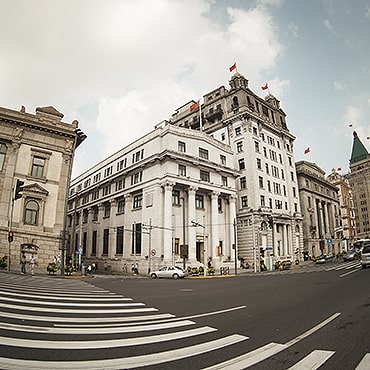The Bund must surely be one of Shanghai’s most recognizable landmarks making it hard to imagine a visit to the ‘pearl of the orient’ without a wander along this iconic boulevard.
So what makes the Bund special?
Ever descriptive in their naming of things, the Chinese call the Bund wai tan (外滩), which literally translates as ‘outer bank’. The word bund is not English in origin, rather it is derived from Persia and means ‘embankment’.
During the 19th century, an influx of Baghdadi Jews settled in the area. In Shanghai and other port cities in East Asia, they established businesses and communities, developing the harbours as they did in Shanghai. The Bund encompasses this riverfront area in Shanghai, holding as much appeal today as it did for those who brought it life originally.
The Bund: Wall Street of the East

Behind an appealing facade of river views and lovely buildings, there is another story, however.
The Bund – and Shanghai’s modern history generally – is intimately linked to trade, opium, and colonialism.
In 1842, the Treaty of Nanking (Nanjing) ended the first Opium War between China and Great Britain. The first of a number of ‘unequal treaties’ between China and foreign imperialist powers (Great Britain, France, Germany, Russia, the United States, and Japan), the Treaty of Nanjing saw China cede territories to Britain. Included among these were Hong Kong, Shanghai, and four other port cities, which were opened up for foreign trade and occupation.
In 1845, the British Concession was established. Wharves and trading houses were set up along the Huangpu River. In 1863, the British and American settlements merged, forming the Shanghai International Settlement in this waterfront area.
The appeal of Shanghai as a commercial hub grew, leading to development of western style buildings – consulates, hotels, trading firms, clubs, and banks – which are now synonymous with the Bund. With this pedigree in commerce, it’s hardly surprising it was regarded as the ‘Wall Street of the East’.
Is the Bund worth seeing?

Well, of course our response to this is completely biased: Yes, it is!
The Bund runs 1.5 kilometers from south to north. It is an eclectic miscellany of buildings and architectural styles, incorporating Baroque, Gothic, Classicism, Romanesque and Renaissance, a reflection of the spirited, vibrant city that emerged during its peak, the period between 1920 and 1937, when the Japanese captured the Chinese part of the city.
If you have an affinity for art deco, you’ll be delighted. Some of the best Art Deco buildings in the world can be found here, and there is an enduring sense of vintage Shanghai to be found in many places along the Bund. Despite the variety in architecture, there must have been an alignment of vision in design, as the skyline is surprisingly homogenous, and often referred to as an ‘international architecture exhibition’. Be sure to wander at a relaxed pace to take it all in.
At a time when Shanghai thrived on the glamor, commerce, and fashion, Shanghai became known as Paris of the Orient, and the Bund was at its epicentre. Although there have been many changes since, Shanghai continues to hold appeal for travelers and expat with a sense of adventure.
What will you discover at the Bund?
With buildings a major highlight on the Bund, take time to explore these stand-outs.
HSBC Building

Completed in 1923, the HSBC Building was the former headquarters for the Hong Kong and Shanghai Banking Corporation. At the time, it was the largest bank building in the Far East and second largest in the world. To top it off, the HSBC Building was considered the most luxurious building between the Suez Canal and Bering Strait – and after a wander through its foyer, we feel sure you’ll agree.
It retains an air of understated elegance and wealth that will have you whispering in awe. The stunning mosaic ceiling alone is worth the visit. Featuring the 12 zodiac signs and global financial centres, it is a beautiful artwork that will have you looking towards the heavens.
While its heyday may have passed, the building’s current owner, the Shanghai Pudong Development Bank, is keeping the door to glamor open, if only a little.
Shanghai Club

When we think of vintage Shanghai, it usually conjures up images of glamorous women wearing cheongsams and cigarette smoked men in tuxedos, and certainly that image wouldn’t be out of place at the Shanghai Club. Founded in 1861, it was a gentleman’s club for British residents in Shanghai.
Construction on the original building was completed in 1864, while another building was developed and opened later in 1910. Its claim to fame? Well, it was the first building constructed in Shanghai with reinforced concrete. However, its greater appeal was the famous L-shaped ‘long bar’, which just so happened to be the longest in the world at the time. The good news is, you can still visit, as it is now part of the Waldorf Astoria Shanghai on the Bund.
Customs House

Truly symbolic of the Bund, Customs House is perhaps the quintessence of old Shanghai. Opening in 1927, Customs House is famous for its clock tower and clock, the largest in Asia. The clock and its bell, which is a replica of the Big Ben at Westminster, were both manufactured in England and shipped to Shanghai.
Peace Hotel

The Peace Hotel with its green pyramid roof is yet another iconic landmark of Shanghai. Considered an exemplar of art deco architecture, it was built by real estate and business magnate, Victor Sassoon.
Like the street on which it was built, the Peace Hotel is rich in history. The penthouse was occupied by Victor Sassoon himself, while floors four to nine were taken as the Cathay Hotel. As the hotel of choice for discerning visitors at the time, it attracted many of the world’s political, artistic, and business elite, with Noel Coward, Charlie Chaplin, George Bernard Shaw, and Chiang Kai-Shek among them.
The Peace Hotel is the tallest building in the Bund, reaching to 77 meters. While small by comparison to the cloud-topping highrises on the opposite side of the Huangpu River, during the peak of its popularity, the Peace Hotel naturally held great appeal. So great was the influence of the building’s owner that when the Bank of China proposed to construct a taller building right next door, the design had to be scaled back to meet Mr. Sassoon’s insistence that no building could top out his own.
Originally built as the Cathay Hotel, in 1956 the hotel reopened the Peace Hotel, and then after a three year renovation, it reopened again in 2010 as the Fairmont Peace Hotel. If jazz appeals, check in for a drink and enjoy The Old Jazz Band who play there. With musicians ranging in age from mid-sixties to nearly a hundred, be inspired by their individual stories and their creativity that keeps them playing such vibrant music to audiences from all around the world.
Former Consulate-General of the United Kingdom

As one of the oldest buildings on the Bund, the Former Consulate – General of the United Kingdom consisted of a compound of five buildings within which was a spacious garden. It was built in a Renaissance style in 1873 and is now a function venue.
Enjoy the Bund at night

Of course, the old buildings are only one part of the Bund’s appeal. On the other side of Huangpu River, which is clearly visible from the Bund, there is more to be discovered. Development of Lujiazui began in 1990 and since then has become the most important financial and commercial centre in China. Many skyscrapers have been constructed over the past three decades, providing offices for local and international corporations, banks, hotels and shopping centres. Certainly, these highrises have far eclipsed the height of their Bund counterparts, however, they represent an altogether different time and space in Shanghai’s history.
Among the famous landmark buildings in Lujiazui are the Oriental Pearl Tower (468 meters); Shanghai Tower (128 floors/632 meters); Shanghai World Financial Centre (101 floors/492 meters; including three observation decks); Jin Mao Building (93 floors/421meters), Bank of China Tower (53 floors/226 meters). And a fun fact for you: Tom Cruise bungee jumped from the Bank of China in Mission Impossible III.
If you don’t fancy crossing the river, walk the Bund esplanade at night when you can enjoy the mix of old buildings contrasted with the impressive modern Lujiazui highrises. While you’re in the area, take an evening cruise that allows you to immerse yourself fully in the city’s magnificent skyline at night.
If you’d love to experience the Bund firsthand with someone who knows it well and can bring it to life, consider booking a Shanghai day tour , or visit Shanghai for a layover, or as part of a multi-day China tour . Discover real China with people who really know it. Incorporating bilingual guides, flexible itineraries, options for private and custom tours, you’ll feel cared for every step of your journey. Reach out to our travel team. We are here to help.
| Entry Prices | |
| Adults | Free |
| Children | Free |
| Food | Yes | There are many restaurants in the precinct around the Bund. |
| Transport | Yes | Bus, subway and taxi |
| Tours | Yes | |
| Family friendly | Yes | |
| Close to city | Yes | |
| Opening hours | Monday – Sunday Open all hours |




 Great tour with Linda in Beijing
Great tour with Linda in Beijing





